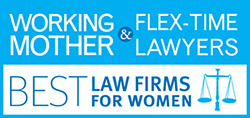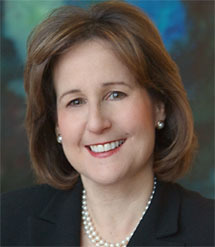In a recent post, Vivia Chen, chief blogger for The Careerist, expressed concern about Working Mother’s list of the top 50 law firms for women (“Can You Trust Working Mother’s List of Top Family-Friendly Firms?”). The top-50 list was first published, in collaboration with Flex-Time Lawyers, three years ago, based on voluminous detailed reports supplied by participating law firms.
Ms. Chen found this year’s list to be of particular interest in light of Slate’s piece on Working Mother‘s sister list: the top 100 companies for women. Slate blogger, Sharon Lerner, reported that this list has for more than ten years included Novartis, a company just hit with a stunning $250 million punitive damages award for sex discrimination.
Read the article in The Careerist, which turns our attention to the law firm list, describes the factors considered in selecting the top family friendly firms and highlights the core concern raised by any list of this kind: Without additional investigation, how can one be sure that the firm’s report fairly reflects reality?
A few thoughts……..
First, a classic baby-boomer caveat:
When I graduated from law school 30 years ago women law students made up only 25% of the class. Still, we began our careers with great optimism (like our equally naive business school sisters no doubt), confident that our gender would be fully represented among partners and management in our firms by the time we were in our prime.
Thus, it will come as no great surprise that the Working Mother/Flextime Lawyer survey report does not comfort me.
Winning a berth on the Working Mother Top 50 (even the Top 10) Best Law Firms for Women, does not, in and of itself, a “family-friendly” law firm make. That judgment may be a tougher call once you have read the detailed survey statistics. In 2010, women outnumber men in many law schools and colleges. Unsurprisingly, therefore, women make up 45 to 50% of the associates at many of the firms surveyed. However, when only 15 to 20 per cent of a firm’s equity partners are women, the availability of a lactation room, a generous reduced hours policy or a neutral full vs. part-time work allocation system is not, to my mind, cause for celebration of any institution on a “Best of” list.
Step One: Real Progress? What Do the Hard Numbers Tell You
Statistically accurate data is always useful. The more the better. And the Working Mother/Flextime Lawyer survey results make an important contribution to our understanding of the role of women in the legal profession today. However, the “50 Best..” list cannot stand alone, nor should it be used to guide a graduate or lateral job search.
Getting on the 50-Best list is a definite marketing and recruiting coup. The honor will be noted in the firm’s website and in some of the Firm’s print and online marketing materials, including diversity brochures distributed at hiring interviews. But, as is always the fact, the average person will likely not look behind the numerical rank.
To the particular credit of Deborah Epstein Henry (below), CEO of Flextime Lawyers, the Top 50 survey generates a wealth of useful information, including percentages of women associates, partners and counsel, statistics for lawyers using flextime or part-time and the number of weeks offered for parental leave.
Of particular note, Flextime Lawyers made certain that the partnership data presented in the report was transparent, drawing the distinction between equity and non-equity partnership, where the Firm has both a capital and income-only partner tiers. This is more than can be said for NALP (The National Association for Legal Professionals), several of whose member firms have refused to disclose this information as to their women and lawyers of color. (One of the firms actuallly based it’s refusal on concerns for the privacy of its partners of color, preferring instead to submit misleading data to law students and others evaluating the firm’s diversity record.)
So, despite my reservations, I do believe that the Working Mother/Flextime Lawyer ranking likely helps generate enthusiasm for a number of diversity policies we all agree are essential. This is no small accomplishment. I am not convinced, however, that policy changes and mission statements necessarily translate into the organic change needed for transformative results.
The real disconnect is in the lens often applied to the hard statistics. Progress must be measured from the top down, and women still constitute a disturbingly low percentage of equity partners. The numbers for managing partners and governing committee members are even more disheartening, particularly for those attempting to raise a family.
To be fair: There are a good number of law firms whose diversity initiatives have yielded meaningful results. There are also many firms who have, in good faith, launched diversity programs and sought to improve the picture, but with little success. Each of these firms deserves our respect…..but look at the statistics, in this and other surveys and reports, rather than simple numerical rank, before drawing conclusions.
Sadly, the available data suggests continued dismal prospects for women in private law practice. If anything, we are losing ground. In a recent survey of 700 women partners*, the “overwhelming majority” said they achieved equity partnerships through lateral moves from other law firms, rather than promotion from the rank and file. Even more disturbing, 7.9 percent of the partners surveyed had been de-equitized, a development most of them attributed to low revenue generation and billable hours and the firm’s need to increase per partner profits.
*The “Survey of Women Partners on Law Firm Compensation,” was jointly sponsored by the Minority Corporate Counsel Association, the ABA Commission on Women in the Profession and the Project for Attorney Retention at the University of California Hastings College of the Law.
Step Two: Look for the Inside Story
Once you have scrutinized the partnership and other telling statistics for a law firm, dig deeper to get a decent read on the firm’s perspective on advancing women. Talk candidly with people you know at the firm, or at least in the firm’s top market(s). You need reliable, but inside, information.
Take, for example, a working mother, or a lawyer looking after an Alzheimer’s afflicted parent, who works on a part-time schedule under a policy described glowingly on his or her firm’s website and in the Top 50 list. Will she be written off by many as “uncommitted” to the practice of law? Will he still have access to good work and mentoring? Will s/he remain “on track”–not simply as a matter of policy, but in the minds of the firm’s most productive partners?
Business is business is business. Its a down economy. Women’s initiatives (all the rage), like a number of other diversity programs, are underfunded, except in firms where the culture has traditionally supported diversity, the client base requires attention to diversity statistics, especially in populating client teams or, in a few rare instances, the high producers have got religion. Exceptions: Firms like Goodwin Procter and McCarter & English, both of whom have recently entered into strategic alliances with 85 Broads (read more at the links.)
Step Three: Need a Docket Search? Google is Your Friend
Finally–for goodness sake (Working Mother, are you listening?), do your research on outstanding discrimination and other unfortunate claims. And read Above the Law and other industry blogs, which actually do an excellent job of piercing the partnership veil. Check their facts, but don’t ignore their warnings.
Solutions?
I cannot blame either Working Mother or Flextime Lawyer for looking on the bright side. It is likely that their collaboration has incented many a law firm to reconsider its HR policies (parental leave, reduced hours) and the support it offers to women lawyers (Women’s Initiatives, mentoring). The 50 Best survey is an agent for change.
But so little really has changed in the past few decades–and young women considering law firm practice need to keep their eyes wide open and their heads clear. They need all the data, and they need the inside story. If they get lazy, and lean on simple magazine rankings, they’ll make mistakes.
It may well be that a free falling economy will have a curative effect, by prompting law firms to adopt the fundamental structural changes required to accommodate a truly diverse workforce (ditching the billable hour, trying out an apprenticeship model, adopting a structure that acknowledges a wider range of contributing skill sets …teaching pigs to fly….). My money’s on a restructuring of the law firm model, including renovation of the billable hours baseline. There are several people thinking about this pretty hard all the time, but my favorites are Deborah Epstein Henry, the “aforementioned” founder of Flextime Lawyers (and creator of the Cheat Sheet and the Top 50 list discussed above), and Lauren Stiller Rikleen (below), author of Ending the Gauntlet: Removing Barriers to Women’s Success in the Law and founder of the Bowditch Institute for Women’s Success. Look soon for a blessedly shorter blog post describing their achievements and suggestions.
To my vaguely jaded (but ever hopeful) mind, the roadblock is cultural, and immensely difficult to break down. Until lawyers and law firms (specifically, their high producers) conclude that the advancement of women and lawyers of color makes good business sense, no real progress is possible. And the business case for diversity does not hinge solely upon whether the firm’s clients are monitoring (better yet, mandating) the makeup of their legal teams, the firm just added a Singapore office or the media has stumbled upon an ugly gender discrimination claim.
It is of greatest importance that law firm management, including the highest producing partners, appreciate the elemental connection between enlightened talent management and profits. (Business school students reflect upon this link in their curriculum. Not so law students.)
Like business development training for young lawyers (the subject of another day’s rants), the strategic advancement of what one diversity consultant calls “outsiders” –women, lawyers of color and LGBT attorneys, should be funded as a hard business cost, driving straight to the bottom line in the global economy. Some firms are onto this idea. Perhaps others will follow.
You may also like:
- Your Good Reputation: Common Courtesy
Business development is about relationships, first and foremost. What goes around comes around. Treat people right or pay the consequences in missed opportunities, broken relationships, burned bridges, and bad word of mouth….
- “Way Too Busy” to Build a Career? (Making Time for…
I can think of a million reasons why I don’t have the time to write this article. Pressing reasons. I’m “flat out”. Last week was “crazy” and it’s all I can do to catch up. I need some sleep. Did I already say that I’m “flat out”? I also have “a f…
- Best Practices for Summer Associates: In Three Simple Charts
A confession: I really really love charts. They help me think clearly. They entertain me. They keep things organized. So this year I offer all you summer associates my customarily blunt “best practices” advice in chart form. Three charts to be exact. Enjoy! And pass them on to the chart-less souls among your friends and family.
- What Do Blogging and Vegas Have in Common?? ….Building a…
It’s not as easy as it was for me–but much remains the same: Industry and skills specialization is still the fastest and smartest route to practice growth. Client contact, on the client’s turf, is still critical. Developing a reputation within your target industry or practice area still requires vastly more than a thorough understanding of the laws and regulations that affect it.




